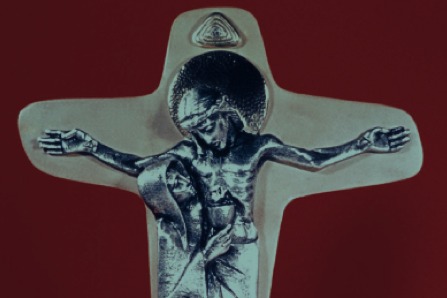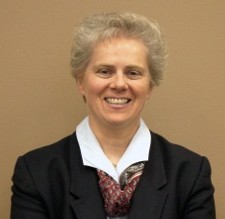The crucifix pictured above uniquely interprets the last recorded encounter of the Blessed Mother and her Son, Jesus. Its Brazilian artist, Fr. Angel Vincente, created this crucifix in 1960 and gifted it to the Schoenstatt Shrine in Santiago, Chile. Due to the close union between Christ and Mary depicted on the image it received the name Unity Cross.
The inseparable bond between Christ and his Mother is archetypical for the Church and hence for the relationship of each Christian to Christ. Both persons are placed within the confines of the Cross: Jesus, nailed through his hands and feet, and Mary with the cup in her hand, standing a little lower but still fully enveloped by the Cross’ outline. Mary’s gaze and arm are directed upwards. Mother and Son, the first redeemed and the Redeemer, look at each other. She loyally abides at his side in this cruel hour, and it appears as if the dying Jesus has elevated his Mother to the most possible intimate union with him.
From crib to Cross, Mary is gradually drawn more fully into the destiny and mission of her Son. Her fiat spoken to the angel Gabriel remains valid for all times and circumstances. Even in this hour of deepest sorrow she heroically repeats her “Yes.” Their heart-wrenching farewell communicates the bond of deep love between these two persons. We may see the reciprocity of their love expressed in the chalice, symbolic of giving and receiving. Christ gives his precious Blood as he offers himself for us to the Father. “Greater love has no one than this: to lay down one's life for one's friends” (Jn 15:13). Jesus’ gift is his pledge of the ultimate sacrifice; it is the highest expression of his love and source of eternal life for us. With his self-oblation, the new and everlasting covenant between God and humanity is sealed. It is the culmination of all divine gifts and graces.
Like the chalice, Mary is completely open and receptive for the precious blood of Christ. Fittingly, she has been invoked as “Precious Chalice” and as “Chalice of Devotion.” In the Liturgy of the Hours’ Morning Prayer for the Common of the Blessed Virgin Mary we pray: Mary the cup, Christ the Saving Blood.[1] As archetype of the Church, Mary embodies the longing of all humanity: to receive the gift of redemption. Her steadfastness at the side of her Son teaches us that, in the light of faith, the Cross is an insurmountable gift. Although his human nature may revolt, Jesus’ promise prevails: “And I, when I am lifted up from the earth, will draw all people to myself" (Jn 12:32).
There is yet another dimension to the chalice: not only is Christ the giver and Mary the receiver of the gift of redemption, but the dying Jesus also receives a gift from his Mother. In this hour of abandonment, her presence must have been a tremendous consolation to him. Like her Son, Mary repeats her trembling “Yes” to all the Father asks of her. In the words of St. John Paul II: “At the foot of the Cross Mary shares through faith in the shocking mystery of this self- emptying. This is perhaps the deepest ‘kenosis’ of faith in human history” (Redemptoris Mater, §18). Her self-gift to her Son is radically unconditional. Thus her heart’s blood spiritually becomes one in the chalice with that of her Son. He alone is the Mediator of the New Covenant; but analogously to God’s covenant in the Hebrew Scriptures, which needed to be accepted by a human person on behalf of the people, Mary standing beneath the Cross on Golgotha accepted the objective plan of redemption in the name of humanity. Her cooperation is active, direct, and necessary. It consisted in accepting and receiving redemption. Lumen Gentium explains that Mary’s contribution to the work of redemption is made through her “manifold intercession” and “maternal charity” (§62), which “neither takes away anything from nor adds anything to the dignity and efficacy of Christ the one Mediator. As the New Eve and Mother of eternal life, she nurtures and sustains the seed of eternal life that the New Adam generates and plants in ‘restoring supernatural life to souls’” (§61).
The Unity Cross reminds us of the famous thirteenth century sequence Stabat Mater. Its verses contemplate the Passio Christi and Compassio Mariae, but not without petitioning the Mother of Sorrows for the grace of aligning our hearts with hers, which is so intimately given to Christ. This Good Friday, we are invited to unite ourselves with Mary’s and Christ’s self-gift. We may ask ourselves: am I like Mary, a chalice longing for Christ’s gift of redemption? Is my relationship to Jesus Christ so intimate that I will remain at his side, even when ridiculed and abandoned by family and friends? And we could also ponder what gift we can add to the chalice. Fear, anxiety, unsolved questions, as well as physical, emotional, and spiritual suffering are our personal contributions for what is lacking in the suffering of Christ (cf. Col 1:24). But we may also offer our gratitude and joy, the many intentions entrusted to our prayer, as well as our experiences of contingency. We can let all of this flow into the chalice where it mingles with the Blood of Christ and awakens the love and mercy of the Father who transforms us into “a spiritual sacrifice of praise and thanksgiving” (Eucharistic Prayer III). While it is not without trepidation that we embrace our personal, professional, and communal crosses, we may confidently place all we have and are in “the Cross, our only Hope.”
![]()
[1] See Frederick M. Jelly OP, Madonna (Our Sunday Visitor: Huntington, IN, 1986), 168.



